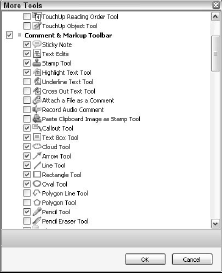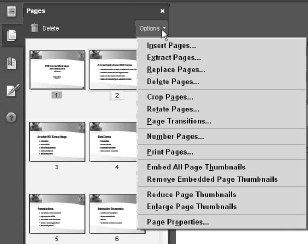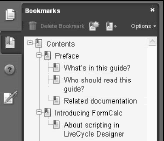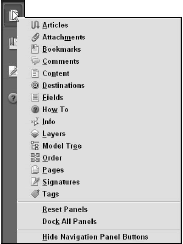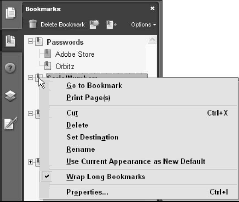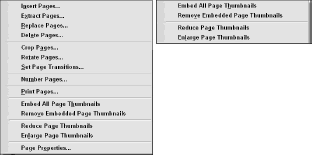Adobe Acrobat Workplace
Whether you’re an Acrobat pro or a new Acrobat user, seeing all those toolbars loaded and scattered across the Toolbar Well the first time can be very intimidating.
As you poke around and possibly feel a little frustration when trying to identify the right tool icon to select the right tool for the task at hand, please realize that Acrobat is a multifaceted program serving a huge array of needs for different users. Not all the tools and features are designed for use in a single Acrobat session.
You may be a PDF forms author and need only Basic tools, Navigation tools, Edit tools, and Form tools. In another session you may be a reviewer and only have need for the Comment and Markup tools.
You might be an eBook author and need to work with many features for creating and viewing eBooks, or you might want to edit PDF pages and post modified PDFs on your Web site. When learning all the tools and commands contained in Acrobat Professional, be certain to look over where tools are discussed.
Learn how to access toolbars and organize them in the Toolbar Well. When you begin a new Acrobat session, set up your environment so you can easily select a tool from toolbars you dock in the Toolbar Well. As a starting point, you can configure Acrobat to provide you with immediate feedback related to tools selection and keyboard shortcuts.
As you first start using Acrobat Professional, follow this steps to help you customize your environment for more efficient editing and less frustration. In this example, an environment for engaging in a commenting session is used. You can change the toolbars to meet needs in PDF editing or PDF creation, or add tools for some other kind of work you do.
- Return to toolbar defaults. Open Acrobat. Position the cursor on any area in the Toolbar Well and right-click to open a context menu (Ctrl+click for Macintosh) and select Reset Toolbars.
- Open the More Tools window. Open the More Tools menu. From a context menu opened from the Toolbar Well, select More Tools to open the More Tools window.
- Add the tools you intend to use to the Comment & Markup toolbar. This is a personal choice. Look over all the Comment & Markup tools and check just those tools you intend to use. Be certain to check the box for the Comment & Markup toolbar so the toolbar shows up when you leave the More Tools window. (See Figure below)
- Add some Edit tools. While still in the More Tools window, scroll to the Advanced Editing Toolbar. One tool you’ll use frequently in almost all editing sessions is the Select Object tool (denoted with an arrowhead icon). Click the check box for this tool.
Other tools won’t be used under most circumstances such as the Movie tool, Article tool, Link tool, and so on. Uncheck all the tools you anticipate not using.
- Add the Spell Check tool. Scroll to the Edit toolbar and check the Spell Check tool.
- Exit the More Tools window. When certain about the tools you think you’ll use in a given editing session, click OK and all the toolbars open as floating toolbars.
- Open the Properties Bar. Again open a context menu on the Toolbar Well and select Properties Bar from the menu options. Note that this tool is not available in the More Tools window and needs to be opened from a context menu or the View >> Toolbars submenu.
- Dock the toolbars. After opening all the toolbars you want to use for a given editing session return to the Toolbar Well context menu and select Dock All Toolbars. This command moves all the toolbars to the Toolbar well, as shown in Figure below.
Palettes
Other tools available to you in all Acrobat viewers are palettes. Palettes are similar to toolbars in that they can be docked to a docking station called the Navigation pane; they can be undocked and floated around the Acrobat window; they can contain pull-down menus for selecting more options.
A series of default palettes appears docked in the Navigation pane; and you can open additional palettes from menu commands. A couple distinctions between toolbars and palettes are that palettes can be placeholders for information, and tools can appear inside a palette.
Whereas tools are used in the Document pane, many palette operations take place directly in the palette. Toolbars remain relatively fixed in size, but palettes can be sized and stretched along the Acrobat window to provide you with more room to work within the palette or view the information contained within the palette.
In addition, some palettes contain their own tools where edits can be made in the palette and dynamically reflected on the document page. Palettes help you organize content, view specific content across many pages, and provide some tools for global editing of PDF files.
Default palettes
As with toolbars, Acrobat displays a series of palettes docked in a well when you first launch the program. Palettes are contained in the Navigation pane along the left side of the Acrobat window.
By default, the Navigation pane is collapsed; however, you can save PDF documents in such a manner where a palette expands when a file is opened in any Acrobat viewer. These settings are document-specific and can be toggled on or off for individual PDF documents.
- Pages - Acrobat users have been familiar with the thumbnail view of each page since the early days of Acrobat. A mini view of each page in the active PDF document is displayed in the Pages pane, as shown in Figure below.
The Pages pane offers you menu options for arranging, deleting, inserting, and editing pages in a number of ways. You can zoom in to the thumbnail views as large or even larger than a page viewed in the Document pane.
- Bookmarks - The second default palette panel in the Navigation pane is the Bookmark panel. You can save PDF documents in a manner where the bookmarks are visible when the file opens in Acrobat.
A good example of such a file is a Help file. When you open a file such as the Adobe Designer FormCalc file, bookmarks are visible in an open Navigation pane, as shown in Figure below.
You can open and close the Navigation panel by pressing F4. You can also grab the vertical separator bar at the right edge of the Navigation pane and move it left and right to size the pane.
Bookmarks are navigation buttons that can launch a page, a view, or one of many different Action types similar to link and button actions. Anyone familiar with Acrobat already knows much about bookmarks and how to navigate pages by clicking individual bookmarks in the palette.
- How To - The How To pane has been moved from where it appeared in Acrobat 6 and 7. In Acrobat 8, the How To pane is docked in the Navigation pane and its behavior is similar to other palettes. Here you find help information on some key Acrobat editing tasks. Click the links and the help information is displayed in the pane.
- Attachments - The Attachments pane in all Acrobat viewers is used to display, manage, and extract file attachments. You can attach files in Acrobat Standard and Professional and extract file attachments using all Acrobat viewers including Adobe Reader.
- Comments - The Comments palette shows you comments in an expanded horizontal view, just like the Attachments pane. When you click the Comments panel, you’ll notice a number of pull-down menus (signified by down-pointing arrows at the top of the pane), a list of comments that can be expanded and collapsed, and a host of tools within the palette.
Hidden Panels
As with toolbars, you can choose to view additional panels through menu commands. You can choose to display a number of other panels in the Acrobat window and dock them in the Navigation pane. To open a hidden panel, choose View >> Navigation Panels.
From the submenu, you’ll find all the panels available. In Figure below, the list shows Navigation panels available in Acrobat Professional.
Another way to access the Navigation panels is through a context menu. Right-click (Windows) or Ctrl+click (Macintosh) on the Navigation pane and a menu shows all the Navigation Panels. In order to see the panels, you must first open them from the Navigation Panels submenu and dock them in the Navigation pane.
Once the panels have been docked, they appear in a context menu, as shown in Figure below.
The list includes the default panels. If you select a default panel, the Navigation pane opens and the panel is selected. When you select a hidden panel, in other words, a panel other than those docked in the Navigation pane when you first launch Acrobat.
The panel opens in the Acrobat window as a floating palette with one or more panels contained in the window. Drag a panel to the Navigation pane and it docks and then becomes visible in a context menu opened from the Navigation pane.
- Articles - The first of the hidden panels listed in the Navigation Panels submenu is Articles. Choose View >> Navigation Panels >> Articles to open a floating palette. Articles enable you to create article threads to help users follow passages of text in a logical reading order. You won’t find any new features added to the Article tool since Acrobat 5.
- Content - A palette designed for managing the structural content of PDF documents is found in the Content panel. When you choose View >> Navigation Panels >> Content, the Content palette opens in a floating palette. Content features help you reflow tagged PDF files and manipulate the structure of tagged documents.
- Destinations - Destinations work similarly to bookmarks, in that specific views are captured and listed in the panel. Clicking a destination opens the associated page in the Document pane, whereas clicking a bookmark opens the associated view (page and zoom).
- Fields - The Fields panel enables you to manage form fields on Acrobat PDF forms. You can list all form fields in the panel and execute menu commands from the pull-down menu and context menu opened from within the palette.
- Info - The Info panel displays the x,y position of the mouse cursor as you move it around the Document pane. From this panel you can choose to display from among three different units of measure—points, inches, millimeters, centimeters, and picas. No changes have been made to the Info palette in Acrobat viewers.
- Layers - If you create documents containing Adobe PDF layers, the Layers palette permits you to toggle layer views and work with layer properties.
- Model Tree - The Model Tree palette lets you examine information related to 3D drawings. You can review assets, hide and show drawing parts, toggle views, review comments, and more on 3D drawings.
- Order - You use the Order panel to manage reading order of documents. This panel also relates to document accessibility, like the options available in the Tags panel. The Order panel enables you to add tags to a document, clear tags, and reorder a page’s contents to change a reading order that might be read aloud by a screen reader.
- Tags - Tagged PDF files provide more editing capability with PDF documents, and the files can be made accessible to adaptive devices such as screen readers. For adding, editing, and annotating tags in PDF documents use the Tags panel. Together with the Content panel options, you have much control over document accessibility.
Palette Menus
Each of the panels contains its own pull-down menu. When a panel is open in the Navigation pane or in a floating window, select the Options down-pointing arrow to open a pull-down menu. Menu commands found in panels may or may not be available from the top-level menu bar. Additionally, some panels, like the Attachments and Comments panels, offer you several pull-down menus.
Context Menus
Context menus can display different options for palette choices depending on where you open a context menu. If you move the cursor to an empty area when all text and objects in a palette are deselected and open a context menu, the menu options may be different than when you select text or an object in a palette.
However, this is not always the case, because a few palettes provide you with the same options regardless of whether something is selected or not. In Figure below a context menu is opened within the Bookmarks panel. In this case you need to open the menu on a bookmark name.
If you attempt to open a context menu in an empty area in the pane, no menu opens. In Figure below, a page in the Pages pane is selected and a context menu is opened on the page, as shown on the left side of the figure.
On the right, a context menu is opened in an empty area in the pages pane. This figure illustrates the different menu options some panels have when selecting an object versus an open area in the pane.
